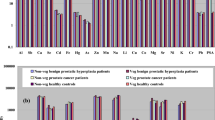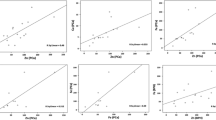Abstract
The objective of this study was to test the hypothesis that prostatic cancer is associated with the changes of zinc (Zn) and cadmium (Cd) concentration. Normal prostate, benign prostatic hyperplasia (BPH), and prostatic carcinoma (PCA) were analyzed for Zn and Cd by atomic absorption spectrometry. Cd level was measured using a graphite furnace and Zn level was measured by flame mode. Metal content was assessed in whole tissues and in nuclear, plasma membrane, and cytosolic fractions. An increase of Zn content in BPH, but a decrease in PCA as compared to normal tissue, was observed. Cd concentration appeared to be higher in BPH and PCA than in normal tissue. No correlation between Zn and Cd level was found in BPH specimens obtained from the same patients. Probability values ofp ≤0.05 were considered to indicate significant differences. Obtained results seem to support the hypothesis of Cd carcinogenicity and preventing function of Zn in prostatic cancer. Plasma membrane fraction corresponding to lysosomal, mitochondrial, and microsomal subcellular compartments are probably critical in Zn and Cd participation in human prostate neoplasms.
Similar content being viewed by others
References
M. J. Wilson, Proteases in prostate development, function, and pathology,Microsc. Res. Tech. 30, 305–318 (1995).
Y. Ochiai, J. Inazawa, H. Ueyama, and I. Ohkubo, Human gene for Β-microseminoprotein: its promoter structure and chromosomal localization,J. Biochem. 117, 346–352 (1995).
D. I. Kleinerman, P. Troncoso, S-H. Lin, L. L. Pisters, E. R. Sherwood, T. Brooks, A. C. von Eschenbach, and J-T. Hsieh, Consistent expression of an epithelial cell adhesion molecule (C-CAM) during human prostate development and loss of expression in prostate cancer: implication as a tumor suppressor,Cancer Res. 55, 1215–1220 (1995).
R. B. Nagle, J. D. Knox, C. Wolf, G. T. Bowden, and A. E. Cress, Adhesion molecules, extracellular matrix, and proteases in prostate carcinoma,J. Cell. Biochem. 19, 232–237 (1994).
G. Aumüller, J. Seitz, and A. Riva, Functional morphology of prostate gland, inUltrastructure of male urogenital glands: prostate, seminal vesicles, urethral, and bulbourethral glands, A. Riva, F. Testa Riva, and P. M. Motta, eds., Kluwer Academic Publishers, Hingham, pp. 61–112 (1994).
R. F. M. Herber, Cadmium, inHandbook on Metals in Clinical and Analytical Chemistry, H. G. Seiler, A. Sigel, H. Sigel, eds., Marcel Dekker, New York, pp. 283–297 (1994).
T. Sorahan, A. Lister, M. S. Gilthorpe, and J. M. Harrington, Mortality of copper cadmium alloy workers with special reference to lung cancer and non-maligmant disease of the respiratory system, 1946–1992,Occup. Environ. Med. 52, 804–812 (1995).
J. W. J. van der Gulden, J. J. Kolk, and A. L. M. Verbeek, Prostate cancer and work environment,JOM 34, 402–409 (1992).
L. Friberg and C. G. Elinder, eds.,Cadmium, Environmental Health Criteria 134, World Health Organization, Geneva (1992).
T. P. Coogan, N. Shiraishi, and M. P. Waalkes, Apparent quiescence of the metallothionein gene in the rat ventral prostate: association with cadmium-induced prostate tumors in rats,Environ. Health Perspect. 102, 137–139 (1994).
M. P. Waalkes, S. Rehm, C. W. Riggs, R. M. Bare, D. E. Devor, L. A. Poirier, M. L. Wenk, and J. R. Henneman, Cadmium carcinogenesis in male Wistar [Crl:(WI)BR] rats: dose-response analysis of effects of zinc on tumor induction in the prostate, in the testes, and at the injection site,Cancer Res. 49, 4282–4288 (1989).
A. Cordova and M. Alvarez-Mon, Behaviour of zinc in physical exercise: a special reference to immunity and fatigue,Neurosci. Biobehav. Rev. 19, 439–45 (1995).
L. Thunus and R. Lejeune, Zinc, inHandbook on metals in clinical and analytical chemistry, H. G. Seiler, A. Sigel, H. Sigel, eds., Marcel Dekker, New York, pp. 667–674 (1994).
E. Cadman, J. R. Bostwick, and J. Eichberg, Determination of protein by a modified Lowry procedure in the presence of some commonly used detergents,Anal. Biochem. 96, 21–23 (1979).
A. L. Partin and D. Coffey, Benign and malignant neoplasms: human studies,Recent Prog. Horm. Res. 49, 293–331 (1994).
Author information
Authors and Affiliations
Rights and permissions
About this article
Cite this article
Brys, M., Nawrocka, A.D., MlekoŚ, E. et al. Zinc and cadmium analysis in human prostate neoplasms. Biol Trace Elem Res 59, 145–152 (1997). https://doi.org/10.1007/BF02783239
Received:
Accepted:
Issue Date:
DOI: https://doi.org/10.1007/BF02783239




